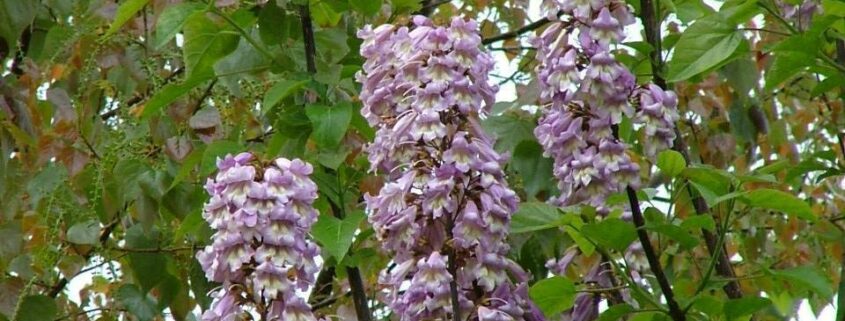Drought Tolerant Trees
Trees are a great addition to almost any garden, creating structure and seasonal interest. Gardens provide a sanctuary and respite from the busy world and planting trees are adapted to hotter, drier climates could be useful to these changing climatic conditions.
Here we list our top 10 trees that are suitable for hot dry or heat wave summers.
We have a range of quality trees for suitable as specimens, screening or for small gardens; just ask our horticultural experts.
Top 10 Trees for hot dry summers
- Betula pendula (Silver Birch)
- Catalpa bignonioides (Indian Bean Tree)
- Cercis siliquastrum (Judas tree)
- Corylus colurna (Turkish Hazel)
- Crataegus crusgalli (Cockspur thorn)
- Ginkgo biloba (Maidenhair Tree)
- Gleditsia triacanthos (Honey Locust Sunburst)
- Koelreuteria paniculata (Golden Rain Tree)
- Paulownia tomentosa (Foxglove Tree)
- Pyrus calleryana Chanticleer (Callery Pear)
- Betula pendula
This tree, more commonly known as a Silver Birch, has an elegant appearance. As a young tree it has a distinctive white bark with darker lines and shapes decorating the trunk. Its main branches are long and often grow horizontally, creating a semi weeping habit. The Pendula produces yellow catkins in the spring and light green foliage that shoots early and becomes orange-yellow in the autumn. This is a hardy tree which is frost resistant and regularly the first to grow back on bare or damaged land.
- Catalpa bignonioides
The Indian Bean tree originates from America. It is a magnificent medium to large tree which comes into leaf late and produces exotic orchid-like flowers in mid-summer followed by beans in the autumn. The leaves turn a pale yellow in the autumn. A good specimen tree.
- Cercis siliquastrum
Cercis siliquastrum is a bushy, deciduous small tree which produces its bloom straight from the trunk and stems. The rosy-lilac, pea-like flowers cover the wood in May, producing a stunning floral display that is quite uncharacteristic of a tree. Following the flowers, the bright green, almost heart shaped leaves are developed on the Judas tree, later accompanied by dark purple tinted seed pods in July.
- Corylus colurna
Also known as the Turkish Hazel, Corylus colurna is a stately and imposing tree at maturity. Its leaves are bright green and are broadly heart shaped. During the early spring long, yellow catkins are produced, followed by clusters of nuts that are contained in frilly looking husks in autumn. It has a rough, corky bark that becomes more distinguished as it matures.
- Crataegus crusgalli
Crataegus crusgalli (or Cockspur thorn) is a small tree with horizontal, spreading branches and a flat-topped shape at maturity. It has showy white flowers, brick-red fruits, glossy summer and vibrant, multi-coloured autumn foliage, and bold winter texture.
- Ginkgo biloba
The Ginkgo biloba or Maidenhair Tree has bright green fan-shaped leaves, with two leaf blades. In autumn time, these wonderfully shaped leaves turn a clear and bright yellow. Ginkgo biloba forms a large specimen with a conical shape at maturity. It is extremely hardy and is a great choice for parks and avenues. Mature female plants produce fruits which bear a distinctive smell.
- Gleditsia triacanthos Sunburst
The Gleditsia triacanthos or Honey Locust Sunburst is a pretty and delicate looking tree which has a rounded and spreading form. The frond-like foliage is often late to appear, emerging a brilliant lime yellow colour and ageing to light green as the summer progresses. Unlike its parent, this cultivar is thornless.
- Koelreuteria paniculata
Koelreuteria paniculata is known as Pride of India, or the Golden Rain Tree. Its profuse small yellow flowers develop in late spring and these form lantern-shaped fruits that turn red in the autumn when its green leaves turn a rich yellow. Grow as a specimen tree in well-drained or moist but well-drained soil in full sun Golden Rain Tree thrives best on free draining soils with a sunny aspect.
- Paulownia tomentosa
The Paulownia tomentosa or Foxglove tree, is a pretty and an unusual tree; it has extremely large, bright green, hairy leaves which can reach up to 30cm across and appear to come directly from the bare wood of the tree. In May this tree will produce large spikes of rich purple flowers, very similar to the foxglove. It is fast growing and sprawling, the wood is very light making it easy to prune. Paulownia tomentosa does best in sunny, reasonably sheltered sites.
- Pyrus calleryana Chanticleer
The Pyrus calleryana Chanticleer or Callery Pear is a medium tree, with side branches stretching upwards creating a narrow, conical shape. It has ovoid leaves, which emerge as early as March and are a glossy, lush green which last through to November, when they change to a reddish-purple before falling. It produces a small, pear-shaped fruit around 1 cm thick.
Pyrus calleryana Chanticleer is a very hardy tree and is resistant to frost, heat, wind and pollution.


